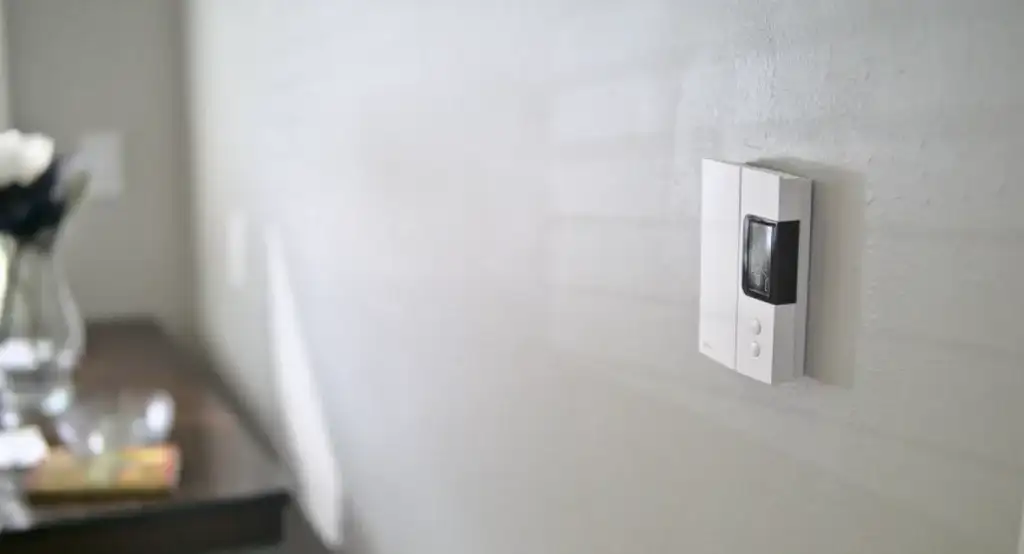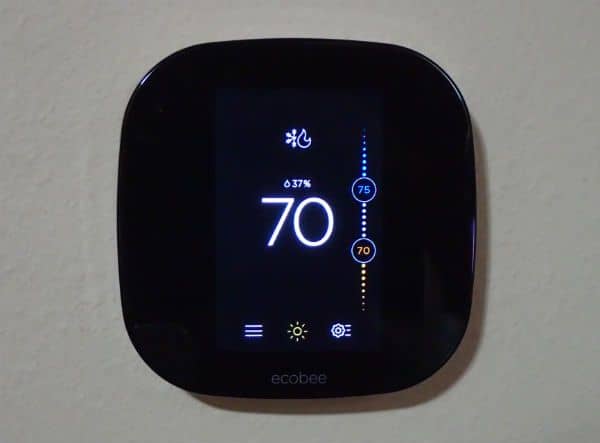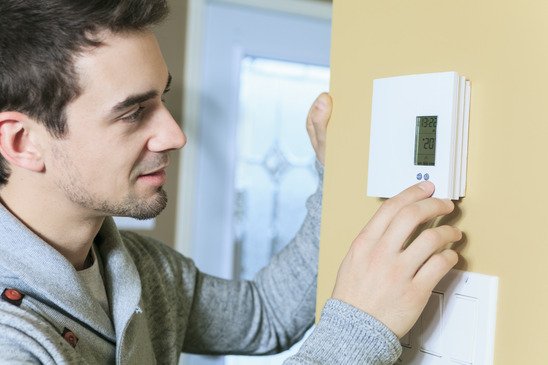Sinopé sent me the Sinopé TH1123WF thermostat free of charge to test and review. As usual, I am under no obligation to say nice things about it, but I will anyway because it’s a good product.
The TH1123WF is a WiFi smart thermostat for line voltage devices (see more like this). I’ve been using it for the past 4 months (as of Jan ’22) and have zero complaints.
This thermostat took the place of my old Mysa thermostat(1st gen), which I really liked. So far, the Sinope performs just as well. It’s just as reliable and includes basically all the same smart features. Plus, I prefer the look and the smaller footprint of the Sinope.
This thermostat is a clean, compact unit that looks right at home on the wall of a modern home. It has an informative display that keeps you up to date on the current temperature inside and outside.
It uses TRIAC control so that it runs your electric heater quietly (no on/off clicking noises) and efficiently.
It can connect it to all 3 major voice assistants for quick, hands-free control. Also, you can connect it to SmartThings for more advanced home automation.
Prices pulled from the Amazon Product Advertising API on:
Product prices and availability are accurate as of the date/time indicated and are subject to change. Any price and availability information displayed on [relevant Amazon Site(s), as applicable] at the time of purchase will apply to the purchase of this product.
Compact, Clean Looking Thermostat
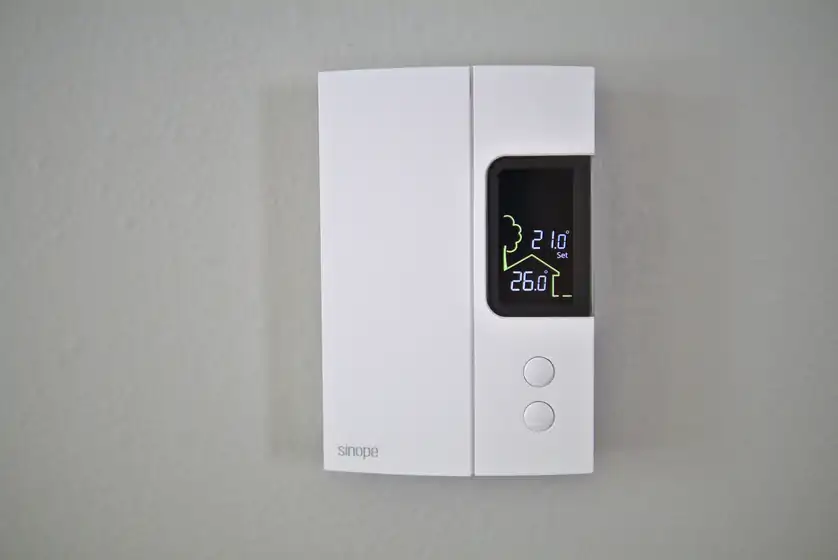
Most people that need a line voltage thermostat are going to need a few of them throughout their home. Therefore, if one of these thermostats is hanging on the wall in every room, you want it to look nice.
The Sinopé thermostat has a clean, compact look. When I installed the Sinopé, it replaced a Mysa thermostat. I was surprised with how much smaller the Sinopé was, and I also feel it has a more “professional” look to it (my Mysa is a version 1 but they have since released a version 2 which is similar in size to the Sinopé).
It seems to be built pretty well, too. It has a sturdy plastic housing and a hard plastic cover to protect the display (not a touchscreen).
The display has crisp, white letters on a dark background which makes them easy to read.
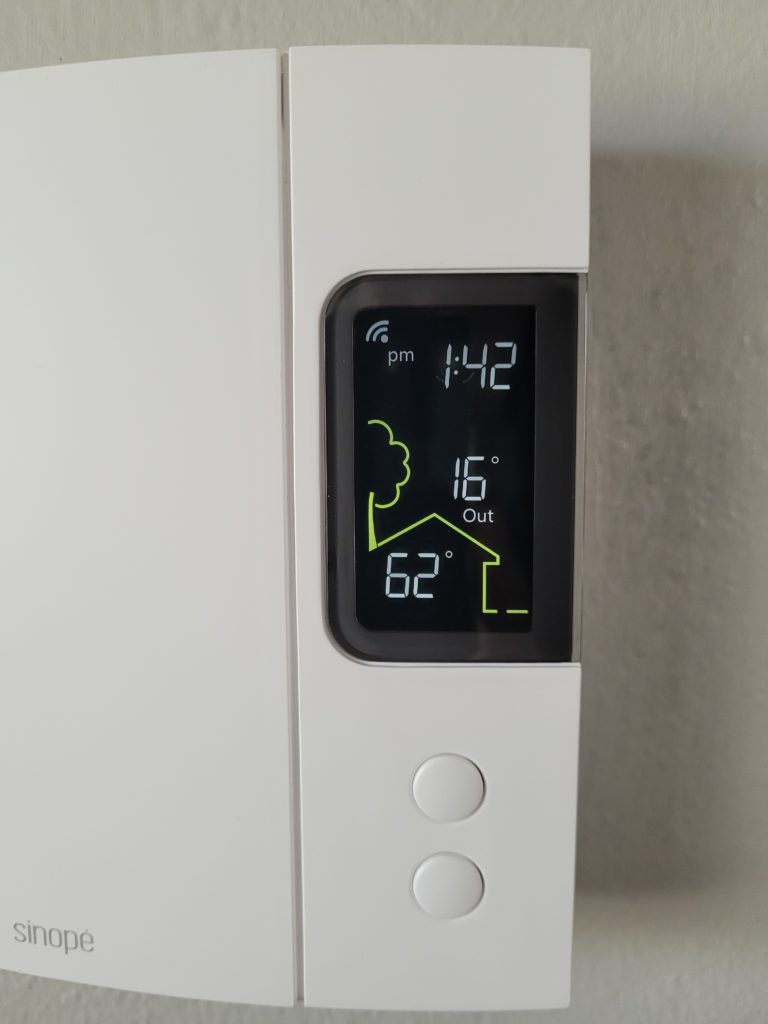
The Sinopé’s display is filled with information including:
- Inside temperature
- Outside temperature
- Time
However, the screen is fairly small which makes it difficult to see beyond a few feet. I am used to the Mysa which has less information, but constantly displays the current temperature large enough to see from across a room.
Quiet, efficient operation
Have you ever been around a thermostat that “clicks” every time the heat turns on or off? That click is caused by a device called a relay inside the thermostat.
This Sinopé thermostat doesn’t have a relay. Instead, it has a device called a TRIAC. What that means for you is that you will never hear the click noise when the heat turns on or off. The thermostat operates in silence.
Additionally, the TRIAC allows the switch to be turned on/off really quickly. The rapid switching capability allows your heater to operate at levels less than 100%.
That means with the Sinopé thermostat in control, you can get a more efficient, even heat. This is especially true with radiant type heaters. In my opinion, TRIAC control is a must have feature if you have a radiant heater.
Reliable WiFi
I know many people use these thermostats in cabins or other remote locations. For that application, you need a reliable WiFi connection. The last thing you want is to be miles away and suddenly your smart thermostat stops responding.
The WiFi connection for the Sinopé thermostat has been rock solid. I had a brief issue when I was initially setting it up, but since then I have had zero issues. It reliably maintains a constant connection and consistently recovers its connection after a power outage.
I’ve been reviewing smart home products for over 5 years now, and it blows my mind that there’s still companies that release products which can’t maintain a reliable WiFi connection. Fortunately, the Sinopé WiFi thermostat has no problems in this department.
What systems does it work with?
This smart thermostat is for line voltage systems, which usually means some sort of electric resistance heater.
It works with:
- Baseboard heaters
- Convectors (short cycle)
- Fan-forced convectors (long cycle)
- Radiant ceiling heaters.
Additionally, it can work with either 2-wire or 4-wire installations.
It will NOT work for central heating systems, which typically require a low voltage (24V) thermostat such as Nest or ecobee.
It is NOT designed to work with electric floor heat. However, Sinopé does sell this thermostat which IS designed to work with electric floor heat. Here’s a few others that work for electric floor heat as well.
Neviweb app is packed with features
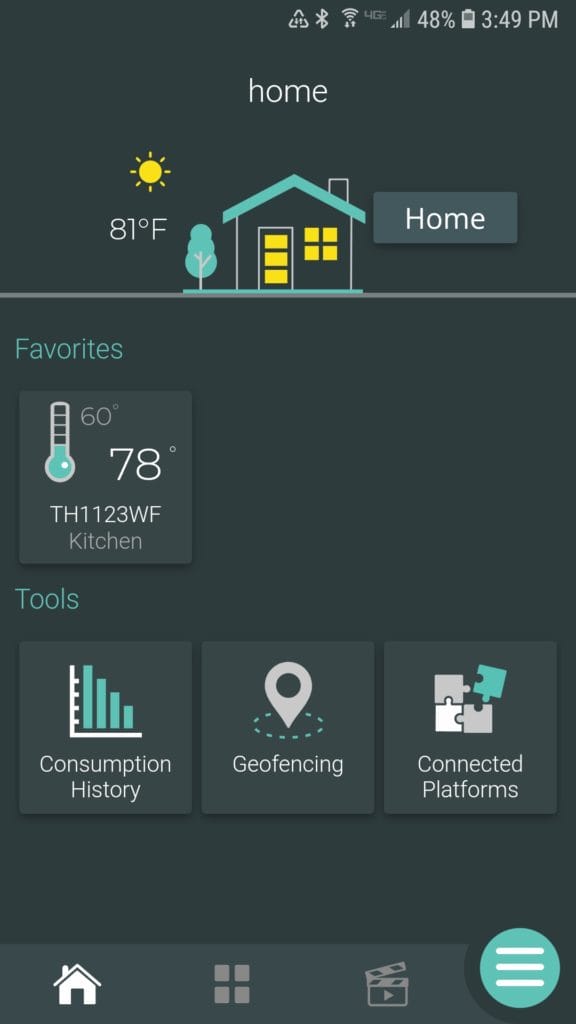
The Neviweb app for the Sinopé thermostat works smoothly and reliably, and also includes a surprising amount of features.
It’s more than just an app for the Sinopé thermostat. In addition to thermostats, Sinopé also makes switches, outlets, and water damage protection products.They all can be connected using the Sinopé GT130 Gateway and subsequently controlled using the Neviweb app.
The app is required to link your thermostat to a voice assistant. Neviweb supports all three major voice assistants (Alexa, Homekit, and Google) and also integrates with SmartThings.
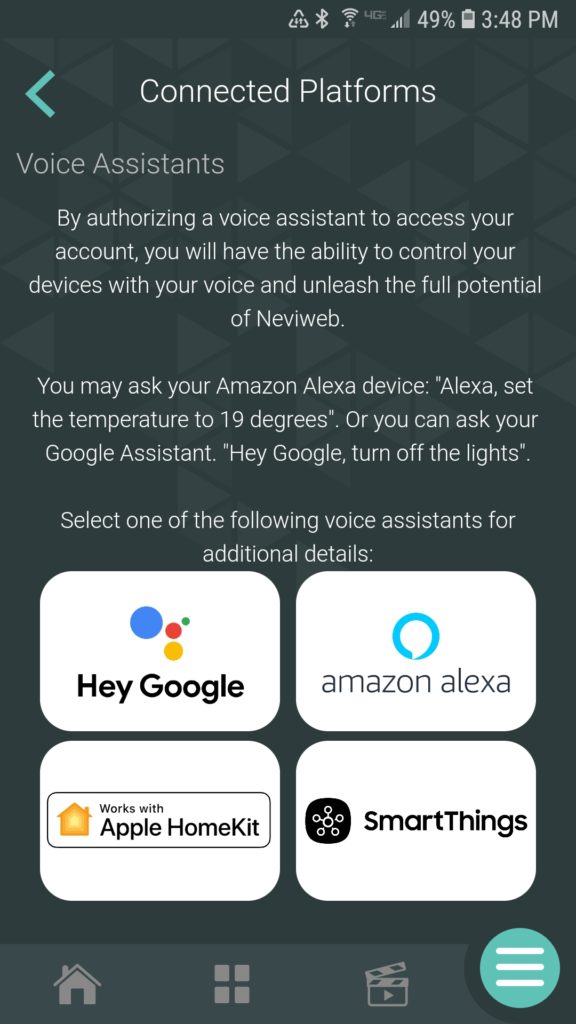
The Neviweb app also includes a native geofencing feature. This allows you to use your phone’s location to determine whether you are home or not.
In order to use the geofencing, you use the app to define a radius around your home. When you leave that zone, your Sinopé device will be set to “Away” mode. When you enter the zone, it will return to the “Home” settings.
As someone who has been using a smart thermostat for over 5 years, I’ve found that the geofencing feature (for any smart thermostat) has been the most useful feature for saving energy.
The last feature I wanted to point out is the energy usage statistics. The Neviweb app shows a graph of your energy usage. It can be broken down into monthly, daily, and hourly time periods.
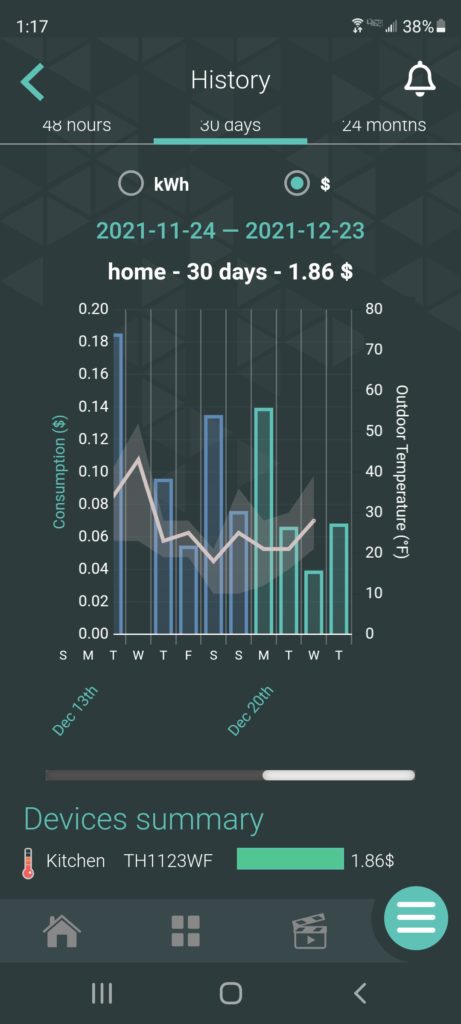
Most other smart thermostat apps have a very similar feature. However, the Neviweb app takes it a step further by including all the other Sinopé devices that can be connected to it. Therefore, if you also have some of the Sinopé switches or outlets, the additional power used by those devices will be accounted for as well.
Which model should you choose?
Currently, Sinopé sells four different variations of this line voltage thermostat. They differ by wireless protocol (either Zigbee or WiFi) and maximum load as follows:
| Model | Wireless Protocol | Max Load |
| Sinopé TH1123WF | WiFi | 3000W @240V 1500W @120V |
| Sinopé TH1124WF | WiFi | 4000W @240V 2000W @120V |
| Sinopé TH1123ZB | Zigbee | 3000W @240V 1500W @120V |
| Sinopé TH1124ZB | Zigbee | 4000W @240V 2000W @120V |
The WiFi versions will connect directly to your router. Therefore, they don’t need any additional hub.
However, the Zigbee versions require a Zigbee hub. You can use either the Sinopé GT130 Gateway, or any other Zigbee hub. If you want to use the Neviweb app and the features it provides, you need to connect using the GT130.
Whether to get the 3000W version or 4000W version depends on the maximum load of your heater. The 4000W versions are a little more expensive, so if you don’t need the extra wattage, you can save a little money by going with the 3000W versions. However, the cost difference isn’t much, so if there’s any chance in the future you might need the extra wattage, you might as well do a little future-proofing and go with the 4000W capacity now.
Troubleshooting
If I encounter any problems while using this device, I’ll make a little entry here. So far, I only had one minor issue.
- Device won’t connect to WiFi
When I initially installed the thermostat, I had a slight difficulty connecting it to my WiFi. Using the Neviweb app, I could find the thermostat and my WiFi network, but when I put in the WiFi password, it failed to connect the two together. I suspect it had to do with dual band WiFi on my router.
The solution was relatively simple. I put my phone into airplane mode, but made sure that the phone was still connected to WiFi. Then, I repeated the connection process and it worked. Here is the Sinopé support page that helped me.
Final Thoughts
In my opinion, the Sinopé performs similarly to the Mysa thermostat which I had before this one. They’re both good products. But all else equal, I prefer the look of the Sinopé. To me, it looks more professional, whereas the Mysa looks kind of like a toy. Additionally, I like the extra information on the display. I use the weather info all the time. My thermostat is right next to the outside door, so a quick glance let’s me know if I’m dressed appropriately.
The Sinopé thermostat is a good smart product. I almost never have to think about it. It does its job, working quietly and reliably behind the scenes with minimal input from me.
Prices pulled from the Amazon Product Advertising API on:
Product prices and availability are accurate as of the date/time indicated and are subject to change. Any price and availability information displayed on [relevant Amazon Site(s), as applicable] at the time of purchase will apply to the purchase of this product.
